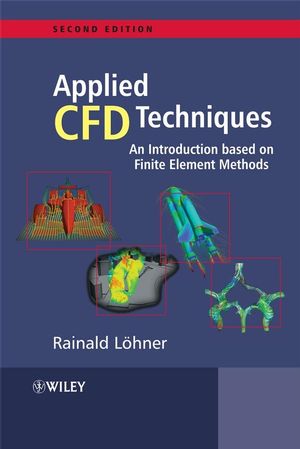Applied Computational Fluid Dynamics Techniques: An Introduction Based on Finite Element Methods, 2nd EditionISBN: 978-0-470-51907-3
Hardcover
544 pages
April 2008
 This is a Print-on-Demand title. It will be printed specifically to fill your order. Please allow an additional 10-15 days delivery time. The book is not returnable.
|
||||||
FOREWORD TO THE SECOND EDITION xiv
ACKNOWLEDGEMENTS xvii
1 INTRODUCTION AND GENERAL CONSIDERATIONS 1
1.1 The CFD code 4
1.2 Porting research codes to an industrial context 5
1.3 Scope of the book 5
2 DATA STRUCTURES AND ALGORITHMS 7
2.1 Representation of agrid 7
2.2 Derived data structures for static data 9
2.3 Derived data structures for dynamic data 17
2.4 Sorting and searching 19
2.5 Proximity in space 22
2.6 Nearest-neighbours and graphs 30
2.7 Distance to surface 30
3 GRID GENERATION 35
3.1 Description of the domain to be gridded 37
3.2 Variation of element size andshape 38
3.3 Element type 46
3.4 Automatic grid generation methods 47
3.5 Other grid generation methods 49
3.6 The advancing front technique 51
3.7 Delaunay triangulation 59
3.8 Grid improvement 65
3.9 Optimal space-filling tetrahedra 70
3.10 Grids with uniform cores 72
3.11 Volume-to-surface meshing 73
3.12 Navier-Stokes gridding techniques 75
3.13 Filling space with points/arbitrary objects 90
3.14 Applications 98
4 APPROXIMATION THEORY 109
4.1 The basic problem 109
4.2 Choiceof trial functions 112
4.3 General properties of shape functions 118
4.4 Weighted residual methods with local functions 118
4.5 Accuracy and effort 119
4.6 Grid estimates 121
5 APPROXIMATION OF OPERATORS 123
5.1 Taxonomy of methods 123
5.2 The Poisson operator 124
5.3 Recovery of derivatives 130
6 DISCRETIZATION IN TIME 133
6.1 Explicit schemes 133
6.2 Implicit schemes 135
6.3 A word of caution 136
7 SOLUTION OF LARGE SYSTEMS OF EQUATIONS 137
7.1 Direct solvers 137
7.2 Iterative solvers 140
7.3 Multigrid methods 153
8 SIMPLE EULER/NAVIER-STOKES SOLVERS 161
8.1 Galerkin approximation 162
8.2 Lax-Wendroff (Taylor-Galerkin) 164
8.3 Solvingfor the consistent mass matrix 167
8.4 Artificial viscosities 167
8.5 Boundary conditions 169
8.6 Viscous fluxes 172
9 FLUX-CORRECTED TRANSPORT SCHEMES 175
9.1 Algorithmic implementation 176
9.2 Steepening 178
9.3 FCT for Taylor-Galerkin schemes 179
9.4 Iterative limiting 179
9.5 Limiting for systems of equations 180
9.6 Examples 181
9.7 Summary 183
10 EDGE-BASED COMPRESSIBLE FLOWSOLVERS 187
10.1 TheLaplacianoperator 188
10.2 First derivatives:first form 190
10.3 First derivatives:secondform 191
10.4 Edge-basedschemes foradvection-dominatedPDEs 193
11 INCOMPRESSIBLE FLOWSOLVERS 201
11.1 The advection operator 201
11.2 The divergence operator 203
11.3 Artificial compressibility 206
11.4 Temporal discretization: projection schemes 206
11.5 Temporal discretization: implicit schemes 208
11.6 Temporal discretization of higher order 209
11.7 Acceleration to the steady state 210
11.8 Projective prediction of pressure increments 212
11.9 Examples 213
12 MESH MOVEMENT 227
12.1 The ALE frame of reference 227
12.1.1 Boundary conditions 228
12.2 Geometric conservation law 228
12.3 Mesh movement algorithms 229
12.4 Region of moving elements 235
12.5 PDE-based distance functions 236
12.6 Penalization of deformed elements 238
12.7 Special movement techniques for RANS grids 239
12.8 Rotating parts/domains 240
12.9 Applications 241
13 INTERPOLATION 245
13.1 Basic interpolation algorithm 246
13.2 Fastest 1-time algorithm:brute force 247
13.3 Fastest N-time algorithm:octree search 247
13.4 Fastest known vicinity algorithm: neighbour-to-neighbour 249
13.5 Fastest grid-to-gridalgorithm:advancing-front vicinity 250
13.6 Conservative interpolation 257
13.7 Surface-grid-to-surface-grid interpolation 261
13.8 Particle-grid interpolation 265
14 ADAPTIVE MESH REFINEMENT 269
14.1 Optimal-meshcriteria 270
14.2 Error indicators/estimators 271
14.3 Refinement strategies 278
14.4 Tutorial:h-refinement with tetrahedra 286
14.5 Examples 291
15 EFFICIENT USE OF COMPUTER HARDWARE 299
15.1 Reduction of cache-misses 300
15.2 Vector machines 316
15.3 Parallel machines:general considerations 328
15.4 Shared-memory parallel machines 329
15.5 SIMD machines 334
15.6 MIMD machines 336
15.7 The effect of Moore's law on parallel computing 344
16 SPACE-MARCHING AND DEACTIVATION 351
16.1 Space-marching 351
16.2 Deactivation 365
17 OVERLAPPING GRIDS 371
17.1 Interpolation criteria 372
17.2 External boundaries and domains 373
17.3 Interpolation: initialization 373
17.4 Treatment of domains that are partially outside 375
17.5 Removalof inactive regions 375
17.6 Incremental interpolation 377
17.7 Changes to the flowsolver 377
17.8 Examples 378
18 EMBEDDED AND IMMERSED GRID TECHNIQUES 383
18.1 Kinetic treatmentof embeddedor immersed objects 385
18.2 Kinematic treatment of embedded surfaces 389
18.3 Deactivation of interior regions 395
18.4 Extrapolationof the solution 397
18.5 Adaptive mesh refinement 397
18.6 Load/flux transfer 398
18.7 Treatment of gapsor cracks 399
18.8 Direct link to particles 400
18.9 Examples 401
19 TREATMENT OF FREE SURFACES 419
19.1 Interface fitting methods 419
19.2 Interface capturing methods 429
20 OPTIMAL SHAPE AND PROCESS DESIGN 449
20.1 The general optimization problem 449
20.2 Optimization techniques 451
20.3 Adjoint solvers 462
20.4 Geometric constraints 469
20.5 Approximate gradients 471
20.6 Multipoint optimization 471
20.7 Representation of surface changes 472
20.8 Hierarchical design procedures 472
20.9 Topological optimization via porosities 473
20.10 Examples 474
References 481
Index 515



